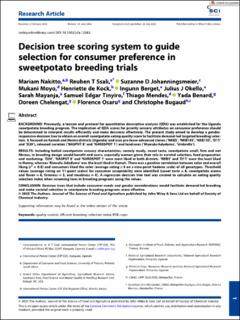| dc.contributor.author | Nakitto, Mariam | |
| dc.contributor.author | Ssali, Reuben | |
| dc.contributor.author | Johanningsmeier, Suzanne D | |
| dc.contributor.author | Moyo, Mukani | |
| dc.contributor.author | Kock, Henriette de | |
| dc.contributor.author | Berget, Ingunn | |
| dc.contributor.author | Okello, Julius J | |
| dc.contributor.author | Mayanja, Sarah | |
| dc.contributor.author | Tinyiro, Samuel Edgar | |
| dc.contributor.author | Mendes, Thiago | |
| dc.contributor.author | Benard, Yada | |
| dc.contributor.author | Chelengat, Doreen | |
| dc.contributor.author | Osaru, Florence | |
| dc.contributor.author | Bugaud, Christophe | |
| dc.date.accessioned | 2023-09-14T07:05:15Z | |
| dc.date.available | 2023-09-14T07:05:15Z | |
| dc.date.created | 2023-09-12T11:18:36Z | |
| dc.date.issued | 2023 | |
| dc.identifier.citation | Journal of the Science of Food and Agriculture. 2023, 1-11. | |
| dc.identifier.issn | 0022-5142 | |
| dc.identifier.uri | https://hdl.handle.net/11250/3089321 | |
| dc.description.abstract | BACKGROUND Previously, a lexicon and protocol for quantitative descriptive analysis (QDA) was established for the Uganda sweetpotato breeding program. The implication of QDA scores for priority sensory attributes on consumer preference should be determined to interpret results efficiently and make decisions effectively. The present study aimed to develop a gender-responsive decision tree to obtain an overall sweetpotato eating quality score to facilitate demand-led targeted breeding selection. It focused on Kamuli and Hoima districts (Uganda) and uses pre-lease advanced clones (‘NKB3’, ‘NKB105’, ‘NKB135’, ‘D11’ and ‘D20’), released varieties (‘NASPOT 8’ and ‘NAROSPOT 1’) and landraces (‘Muwulu-Aduduma’, ‘Umbrella’). RESULTS Including boiled sweetpotato sensory characteristics, namely mealy, sweet taste, sweetpotato smell, firm and not fibrous, in breeding design would benefit end-users, especially women given their role in varietal selection, food preparation and marketing. ‘D20’, ‘NASPOT 8’ and ‘NAROSPOT 1’ were most liked in both districts. ‘NKB3’ and ‘D11’ were the least liked in Hoima, whereas ‘Muwulu-Aduduma’ was the least liked in Kamuli. There was a positive correlation between color and overall liking (r2 = 0.8) and consumers liked the color (average rating ≥ 6 on a nine-point hedonic scale) of all genotypes. Threshold values (average rating on 11-point scales) for consumer acceptability were identified (sweet taste = 6, sweetpotato aroma and flavor = 6, firmness = 3, and mealiness = 4). A regression decision tree tool was created to calculate an eating quality selection index when screening lines in breeding programs using the values. CONCLUSION Decision trees that include consumer needs and gender considerations would facilitate demand-led breeding and make varietal selection in sweetpotato breeding programs more effective. © 2023 The Authors. Journal of The Science of Food and Agriculture published by John Wiley & Sons Ltd on behalf of Society of Chemical Industry. | |
| dc.description.abstract | Decision tree scoring system to guide selection for consumer preference in sweetpotato breeding trials | |
| dc.language.iso | eng | |
| dc.title | Decision tree scoring system to guide selection for consumer preference in sweetpotato breeding trials | |
| dc.title.alternative | Decision tree scoring system to guide selection for consumer preference in sweetpotato breeding trials | |
| dc.type | Peer reviewed | |
| dc.type | Journal article | |
| dc.description.version | publishedVersion | |
| dc.source.pagenumber | 1-11 | |
| dc.source.journal | Journal of the Science of Food and Agriculture | |
| dc.identifier.doi | https://doi.org/10.1002/jsfa.12883 | |
| dc.identifier.cristin | 2174282 | |
| dc.relation.project | Nofima AS: 13110 | |
| dc.relation.project | EU – Horisont Europa (EC/HEU): 862170 | |
| cristin.ispublished | true | |
| cristin.fulltext | original | |
| cristin.qualitycode | 1 | |
